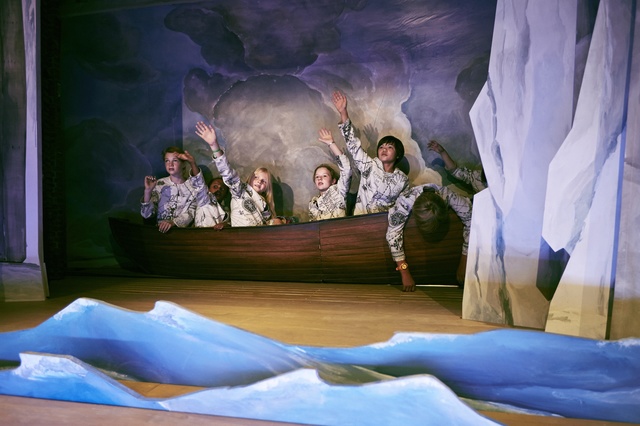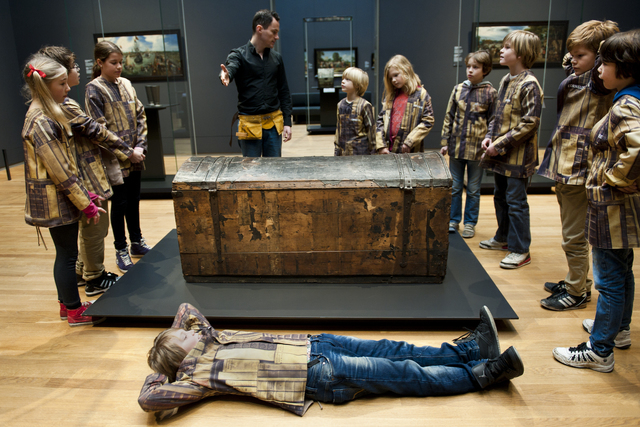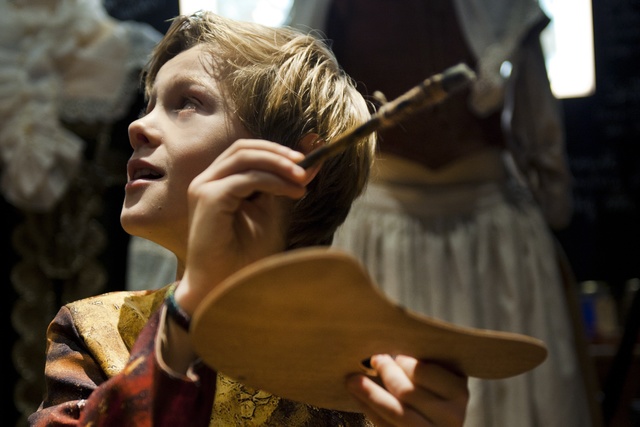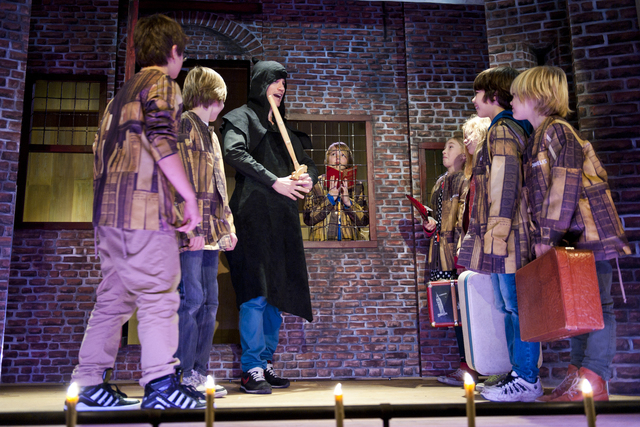
‘Willem Barentzs is dead ...’: Students act out the story of a ship crew’s excruciating winter on Nova Zembla in 1596
History adventure! Expedition Rijksmuseum
Von:
Annemies Broekgaarden (Rijksmuseum Amsterdam), Amsterdam
Expedition Rijksmuseum, an innovative programme designed by the Rijksmuseum Amsterdam, aims to engage students of primary schools and the first grades of secondary school (6-12 yrs./12-14 yrs.) in a number of the most important historical events of the Dutch seventeenth century. The point of departure is ‘learning by doing’. To achieve a maximum degree of identification and surprise, the programme uses a unique combination of film, computer game, physical experience, and drama.
‘History adventure’ is the best description of how children experience this programme. The stories used in the programme are Rembrandt van Rijn’s painting of De Nachtwacht (The Nightwatch), the survival of a ship’s crew on Nova Zembla in 1596, and the spectacular prison break of Hugo de Groot (Grotius).
Conception and planning of the programme
Consultation with audience
Before developing new educational programmes, the Rijksmuseum always consults with the intended audience. In this case, primary schoolteachers formulated two specific wishes: firstly, a new museum programme must substitute part of the curriculum, and secondly, it must use theatre as a medium. Many teachers struggle with their history lessons, which is why the programme adopts an historical perspective: to meet the needs of the educational field and use the strength of the museum.
Developing this programme was teamwork: curators, a theatre company, historians, educators, designers, and text writers all worked together. A special studio was designed and built, and professional actors were trained.
Learning by doing
Because the Rijksmuseum collection belongs to all Dutch inhabitants, the aim was to make sure the programme wasn’t ‘highbrow’ in any way, but in tune with students’ experiences and enjoyable for school groups and families from all walks of life.
Another goal was to engage students in the most important historical events of the Dutch seventeenth century, related to the most important collection of the Rijksmuseum. The point of departure was ‘learning by doing’, as active participation allows for better retention of information. The programme is multidisciplinary: theatre, film, gaming, research activities, and physical experience.
Connecting to the curriculum
The three main historical stories in the programme connect the curriculum of Dutch primary schools to the collection of the Rijksmuseum. Its unique selling point is that the programme substitutes part of the curriculum. Student participation is maximised because the students really become part of the programme. They arrive at the museum fully prepared and connect with the collection immediately.
The programme is offered to students twice a day on schooldays (2.5 hours), and to families with children during holidays and weekends (2 hours). To inform teachers and families, we use a promotional video, a brochure, sneak previews, the website, and social media.
Structure of the programme
The original version of Expedition Rijksmuseum was evaluated on all number of issues. The current version incorporates improvements and currently has the following structure:
1. In the classroom
The teacher receives a package of educational material to prepare the students for their visit to the museum.
The students ‘become’ a character in one of three seventeenth-century stories by playing the computer game ‘Ranking the class’, in which they evaluate each other’s personality to best match the seventeenth-century characters. The students also memorise a number of lines from a play that they will perform in.
The students watch five short films in which they learn about the ‘Society of Historical Secrets’. This ‘society’ works in the Rijksmuseum and applies extraordinary experimental research methods to the three main stories of the programme: Rembrandt van Rijn’s painting of De Nachtwacht (The Nightwatch), the survival of a ship’s crew on Nova Zembla in 1596, and the spectacular prison break of Hugo de Groot (Grotius).
2. In the museum
Once they are in the museum, three ‘researchers’ from the Society of Historical Secrets guide the students through the museum, showing them the real objects and paintings relating to the characters they have become. The ‘researchers’ are in fact professional actors. They connect the collection to the stories and to the students’ knowledge.
3. In the theatre/studio
After the guided tour, the students enter the final and most spectacular phase of the programme.
Each of the three groups of students enter a specially designed ‘historical experience’. For instance, one group steps into a wooden shack, much like the one the ship’s crew built in the seventeenth century to survive on Nova Zembla. The students feel the icy wind and drops of melting snow on their faces. While they’re listening to voices (via hidden speakers), they suddenly hear a polar bear on the roof. Each of the two other groups has a similar ‘experience’ to fit their story. The Rembrandt group steps into the ‘head’ of Rembrandt van Rijn and sees through his eyes while painting his most famous painting, The Nightwatch. The Grotius students experience his spectacular prison break in a giant book crate that wobbles and sways.
After half an hour of practice with their designated actors, the students assemble in the specially built seventeenth-century theatre. The grand finale is a theatrical show, with music, lights, and special effects, in which the students ‘become’ their character on stage and perform their story for their fellow students, a fantastic experience. One student described the programme this way: ‘You play history, that’s the fun!’
Implementing the programme
Teamwork
Carrying out ‘You and the Golden Age’ requires constant teamwork. Each programme is led by a team of three professional actors. Because the students recognise the actors from the film they have watched at school, they immediately feel involved with the story. The personal connection makes it possible to pay attention to every child. To provide a profound physical experience, a theatre designer was hired to design the spaces needed for the programme.
Routing and logistics
We also paid special attention to the routing: students are welcomed in the foyer and shown to the cloakroom. They change into specially designed jackets – that way they are instantly recognisable to tour guides and museum security. The class is divided into three groups that each follow a fixed route through the museum.
After the visit to the museum and a break with drinks and snacks, the students are escorted to the special seventeenth-century studio. Here, they physically experience the historical stories. A show control system operates the lights, the sound, and special effects (cold air, moving objects) and the projectors during the historical experiences and the theatrical show.
Day-to-day contributors
A producer sees to the daily running of the equipment and materials. A director trains, coaches, and monitors the fourteen professional actors involved in the programme. A number of employees from the Department of Education monitor the programme as regards content and maintain contact with the schools. The producer, director, and actors, as well as visiting teachers, point out any problems or obstacles they encounter. Small changes are implemented directly, or if required, via a special training.
Evaluation and remedial process
Testing
Version 1.0 of Expedition Rijksmuseum was tested extensively, twice. The first evaluations and tests were conducted with nine pilot groups of students and their teachers, using observation, interviews, and written surveys. The second evaluation was conducted by an independent historical researcher, who visited schools and spoke at length with teachers and students. One element needed no improvement: the computer game ‘Ranking the class’, in which the students match each other to their characters, proved to be nearly perfect.
Improvements
Other elements of the programme, however, did need improving. One of the main outcomes of the second study, for instance, was that the guided tour in the museum was too short. It was therefore lengthened. Another correction concerned the vocabulary used in the programme: it proved to be too difficult, after which the scripts were amended. A third improvement pertained to the theatrical show. In the original version, students performed the play largely by themselves. The evaluations showed, however, that they needed extra guidance to make it feel more spectacular. The current version therefore uses three professional actors per programme.
Credits und Zusatzinfos:
Credits
All photos: Rijksmuseum Amsterdam
Permanent Link: www.doi.org/10.58865/13.14/234/1
Zitat:
Annemies Broekgaarden: History adventure! Expedition Rijksmuseum, in: neues museum 23/4, www.doi.org/10.58865/13.14/234/1.
Credits
All photos: Rijksmuseum Amsterdam
Permanent Link: www.doi.org/10.58865/13.14/234/1
Zitat:
Annemies Broekgaarden: History adventure! Expedition Rijksmuseum, in: neues museum 23/4, www.doi.org/10.58865/13.14/234/1.











